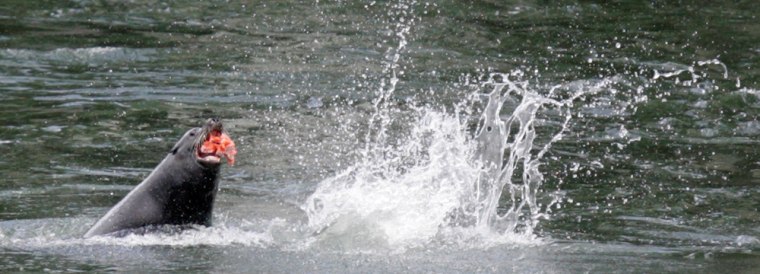Above the spillways of Bonneville Dam, Darrell Schmidt patrolled with his shotgun, drawing a bead on furry brown California sea lion heads popping up from the Columbia River and blasting off a beanbag round.
All spring he was part of a nonlethal, and not very effective, effort to keep the federally protected animals from gobbling threatened spring chinook salmon as they schooled up at the dam's fish ladders en route to upriver spawning grounds.
"I got one on the back of the neck with a beanbag and he didn't even drop the fish he was eating," said Schmidt of the U.S. Department of Agriculture.
Blasts of rubber buckshot, earsplitting pyrotechnics on the river surface and underwater firecrackers haven't helped, either.
In fact, preliminary numbers indicate the sea lions got more salmon this season than in any of the six since records have been kept.
It's the third year wildlife officials have used nonlethal hazing to try to deter the sea lions. But nothing, it seems, trumps the allure of the fat, tasty spring chinook salmon.
Killing any protected marine mammal can bring stiff fines and jail time. Oregon, Washington and Idaho are in the process of getting permission to kill some of the more troublesome animals under the 1972 Marine Mammals Protection Act that shields them. It can take years.
Some congressmen are trying to fast-track the process of allowing "lethal removal" of some of the worst repeat offenders.
"After trying every trick in the book, (lethal removal) is the only option left to stop the sea lions," said Rep. Doc Hastings, of Washington.
The 1972 act protected all marine mammals, some of whom needed it more than others.
Robin Brown of the Oregon Department of Fish and Wildlife said there are perhaps 300,000 California sea lions along the Pacific coast, about six times the number in 1972.
Oregon and Washington wildlife officials figure about 1,200 hang out around the mouth of the river. But Brown said only 100 or so regularly show up at the dam each spring.
Vigilante shootings
Meanwhile, some impatient souls, probably fishermen, are beginning to apply a brand of Western justice.
A California sea lion was shot recently near Portland by a frustrated fisherman who saw it take a salmon from another fisherman's line. He was seen alive a couple days later.
Reports of sea lion shootings have increased in the past two years.
In March, according to Brian Gorman of the National Marine Fisheries Service in Seattle, a half-dozen sea lions were found dead in Washington's Puget Sound and others were found dead on beaches. All had been shot.
The sea lions and their human hazers left the dam in late May, and the U.S. Army Corps of Engineers will use the summer to look at the numbers and evaluate the hazing program.
The Corps doesn't believe it had any substantial impact in deterring the sea lions.
The sea lions, or their relatives, in the river are nothing new. Lewis and Clark mentioned them in their journals in 1806, but fishermen say they eat too much of the threatened spring run, 4.1 percent this year by early estimates. The estimated percentage is higher than in some recent years because the salmon run was smaller.
Lethal removal was tried once before, in the 1990s, when Washington state received a permit under the 1972 act to kill some of the sea lions at the locks in Seattle's Ballard neighborhood, but Sea World took three of the worst offenders before they could be killed.
The sea lions had nearly eradicated a steelhead run there.
Once, an estimated 16 million salmon returned annually to the Columbia and its tributaries. Fish managers hope for a tenth of that today, and 13 salmon and steelhead species are protected under the Endangered Species Act. The spring chinook run is listed as threatened, which means it could become endangered and eventually extinct.
Robert Stansell, a fish biologist at the dam, said the Corps knows its tactics fall short but it needs to make a good-faith effort to prove it before taking stronger measures.
Fast swimmers
Oregon has trapped a few sea lions and trucked them to the river's mouth near Astoria hoping they would get the hint. But they can and do cover the 144 river miles back upriver to the dam in two days.
Many have been branded to track their movement. The brands, plus scars and other markings, help identify the repeat offenders.
Stansell has come to know many of them.
As C265 cruises by, Stansell recounts how he was trapped and weighed near the river mouth in March at 559 pounds. He was found there again after spending more than two months below the dam and weighed 1,043 pounds. He has been a regular visitor at Bonneville since at least 2002.
The Humane Society of the United States calls the "lethal removal" campaign a red herring.
"It won't save declining salmon runs in the Columbia River, because the sea lions aren't the problem," said Sharon Young, the society's national marine issues field director.
The society blames poor fishery and water management, substantial bird predation on young salmon headed to sea, hydroelectric dams, damage to spawning areas and other factors.
"It seems that it is easier to scapegoat the sea lions," she said, "than to try to address these other more politically charged and complex issues."
